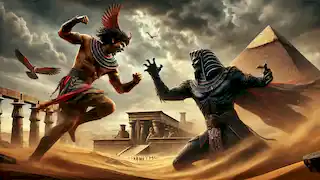The Story of Osiris
Reading Time: 8 min

About Story: The Story of Osiris is a Myth from egypt set in the Ancient. This Dramatic tale explores themes of Justice and is suitable for All Ages. It offers Cultural insights. A mythic journey of betrayal, love, and rebirth that shaped ancient Egypt.
In the cradle of ancient Egypt, where the Nile flowed with vitality and the sun god Ra held dominion over the heavens, the tale of Osiris, the god of the afterlife and resurrection, was woven into the spiritual fabric of the people. This myth, preserved through the centuries in ancient hieroglyphs and on temple walls, encapsulates the mysteries of life, death, and rebirth, defining the core of Egyptian belief and tradition. Osiris, once a revered king among mortals, became the deity who bridged the mortal world with the divine, guiding souls into the afterlife and overseeing the cycle of resurrection. This is his story, a tale of power, betrayal, love, and eternal legacy. In the early days of Egypt, Osiris ruled as a wise and beloved king, bringing prosperity and justice to the land. He was known for his fair laws and his nurturing of the people, teaching them agriculture and establishing order. Osiris was not only a king but a god among men, an embodiment of fertility and life. Beside him was his wife, Isis, whose devotion was unparalleled. A goddess of magic and healing, she was as wise as she was compassionate. Together, Osiris and Isis were symbols of unity and strength, reigning harmoniously over the Nile and all its people. Their love and partnership were the foundation of their rule, respected and revered by gods and mortals alike. But this peace and prosperity stirred envy in the heart of Set, Osiris's younger brother. Set, god of chaos and destruction, resented Osiris's influence and sought the throne for himself. His jealousy grew until it festered into a bitter hatred, and he plotted to bring an end to his brother's reign. Set's envy turned to a dark resolve. In secret, he gathered his followers, those who thrived in shadows and disorder. Set's mind was sharp and cunning, his ability to deceive unmatched among the gods. He devised a plan so sinister that even his closest allies hesitated to support him, but Set was persuasive, and his charisma drew them to his cause. On the night of Osiris's grand feast, Set revealed his plan. He presented a magnificent chest, crafted to perfection and encrusted with precious stones. The chest was so enticing that the guests marveled at its beauty, unaware of Set's true intentions. Set announced that he would gift the chest to whomever could fit perfectly within it. One by one, guests attempted to lie within the chest, but none matched its dimensions. When Osiris took his turn, Set's trap was sprung. The moment Osiris lay within the chest, Set and his followers sealed it shut, trapping Osiris inside. With fierce determination, Set ordered his men to carry the chest to the Nile and throw it into the river, where it would be lost to the currents, taking Osiris with it. Thus, Osiris was betrayed, his life taken by the very brother he had loved and trusted. Isis was devastated by the loss of her beloved husband. Her grief was as boundless as the desert sands, but she did not let despair consume her. Driven by love and determination, she set out to find Osiris's body, to restore him to life. For days and nights, Isis searched the banks of the Nile, asking all who crossed her path if they had seen a chest or any sign of her lost husband. Isis was no ordinary woman. She was a goddess, with powers that few understood. With her magic, she called upon the winds and the waters, hoping they would reveal Osiris's location. Her journey took her to distant lands, where she encountered beings both mortal and divine, each offering pieces of wisdom or cryptic guidance. Finally, her search led her to the city of Byblos, where she discovered that Osiris's chest had been carried ashore and encased within the trunk of a great tree. With her magical prowess and unbreakable resolve, Isis retrieved the body of Osiris and brought it back to Egypt. Back in Egypt, Isis, along with her sister Nephthys, performed sacred rituals over Osiris's body. The god Thoth, deity of wisdom, joined them, offering his knowledge of the ancient rites. Anubis, god of the dead, assisted in preserving Osiris’s form, giving rise to the first mummification. Through powerful incantations and rites, Isis called Osiris's spirit back from the afterlife. Her magic, born of love and grief, was potent enough to defy death itself, and Osiris was resurrected. However, he was no longer the living king of Egypt but had transcended into a god of the underworld, destined to rule over the souls of the deceased. This resurrection was not complete in the mortal sense; Osiris could no longer walk among the living. Instead, he took his place as the lord of Duat, the Egyptian underworld, where he presided over the judgment of souls. Those who lived justly were welcomed into his eternal paradise, while the unjust were condemned. {{{_02}}} In the aftermath of Osiris’s resurrection, Isis became pregnant with his son, Horus, who would become the avenger of his father. Knowing that Set still thirsted for power, Isis hid with Horus in the marshes of the Nile Delta, protecting him from Set’s wrath. She nurtured him, teaching him wisdom, courage, and the virtues of his father, preparing him for the day he would challenge Set. Horus grew strong and brave, embodying both his father's nobility and his mother's wisdom. As he reached adulthood, Horus knew it was his destiny to confront Set and reclaim the throne that had been wrongfully taken from his family. His resolve was unshakable; he would avenge Osiris and restore order to Egypt. The final confrontation between Horus and Set was epic, a struggle that shook both heaven and earth. Set, powerful and cunning, was a formidable opponent, but Horus fought with the strength of justice and the blessings of the gods. The battle raged across deserts, over the mountains, and along the banks of the Nile, with neither side yielding. The gods themselves took notice, each choosing sides, either supporting Horus or Set. Ra, the sun god, watched closely, torn between his affection for both Osiris and Set. In one fierce encounter, Set gouged out Horus’s eye, nearly blinding him. But Thoth, with his knowledge of healing, restored Horus’s vision, giving rise to the symbol of the Eye of Horus, a powerful emblem of protection and royal power. Ultimately, Horus emerged victorious, though his battle scars served as a reminder of the high cost of justice. Set was defeated and cast out, his power diminished, and Horus ascended the throne of Egypt, ruling with the same wisdom and justice as his father. With Horus on the throne, peace returned to Egypt. Osiris’s spirit, now lord of the underworld, continued to guide and judge the souls of the departed. His reign over the afterlife became a source of hope for the Egyptians, who believed that through righteousness, they too could join Osiris in the eternal fields of paradise. Isis, as the mother of Horus and wife of Osiris, remained a revered figure, a symbol of undying love, resilience, and maternal devotion. Temples were built in her honor, and her magic was called upon by those seeking healing and protection. Osiris’s story became central to Egyptian beliefs, representing the cycles of life, death, and rebirth. His legacy inspired rituals and traditions that endured for millennia, as generations of Egyptians sought to emulate his virtues and honor his name. As the god of the afterlife, Osiris presided over the Weighing of the Heart, a ceremony where the soul of the deceased was judged. In the Hall of Two Truths, Anubis would weigh the heart of the deceased against the feather of Ma’at, the goddess of truth and justice. If the heart was lighter than the feather, the soul was granted passage to paradise; if heavier, it was devoured by Ammit, a creature part lion, hippopotamus, and crocodile. This process embodied the ideals of justice that Osiris had championed during his mortal reign. Egyptians believed that Osiris would reward the righteous and condemn the wicked, thus encouraging a society that valued truth and moral integrity. The story of Osiris, Isis, and Horus became the foundation of Egyptian mythology, symbolizing the victory of life over death and the eternal cycle of rebirth. Through temples, inscriptions, and rituals, Egyptians honored these gods, believing that their blessings ensured both prosperity in life and peace in the afterlife. The Osiris myth endured beyond the age of pharaohs, influencing other cultures and becoming part of the collective understanding of life, death, and resurrection. His legacy, carved into the stone of temples and whispered in ancient prayers, remains an immortal testament to the power of love, loyalty, and justice. In the realm of the gods, Osiris sits as a figure of everlasting power and compassion, forever guiding the souls of the dead through the mysteries of the afterlife, while his story lives on, inspiring those who seek wisdom in life and peace in eternity.The Reign of Osiris

The Plot of Set
The Search of Isis
The Resurrection of Osiris
The Birth of Horus
The Battle of Horus and Set

The Legacy of Osiris
The Judgment of the Dead

Eternal Reverence

















